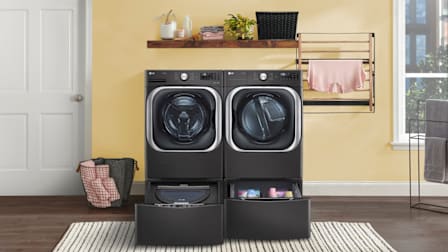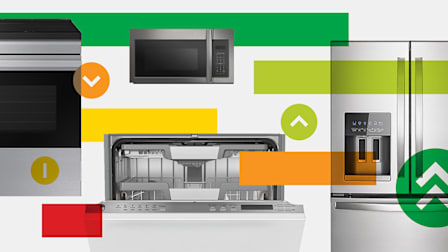Best Front-Load Washers of 2025
Our tests show that you don't have to pay top dollar for a front-loader you can count on
When you shop through retailer links on our site, we may earn affiliate commissions. 100% of the fees we collect are used to support our nonprofit mission. Learn more.
Front-load washers are some of the best washing machines you can buy, with most of the ones that we’ve tested delivering great washing performance.
Best Front-Load Washers
Front-loaders tend to be more energy- and water-efficient than other washer types without compromising cleaning power. All 38 front-load washers in our ratings score highly in our evaluations of energy and water efficiency, as well as washing performance. The models featured below are all Energy Star certified.
LG models are prominent among our top-rated machines because of their excellent washing performance, energy and water efficiency, and high marks for reliability and customer satisfaction, based on CR’s member surveys. But you’ll also find models from Electrolux, Maytag, and Samsung following closely behind.
How CR Tests Front-Load Washers
To evaluate front-load washing machines, Consumer Reports’ testers run 8-pound loads of laundry through the most aggressive normal cycle setting with no added options or extra cycles. Each load, which contains a mix of cotton-based items, also includes fabric swatches with red wine, cocoa, carbon, and other hard-to-remove stains. We use a spectrocolorimeter to measure the swatches’ color intensities before and after washing. The lighter the stain after laundering, the higher the machine scores in washing performance.
Our testers measure water efficiency by calculating the amount of water used per pound of clothing. We allow automatic-fill washers to set their own levels, and for models that don’t include this feature, we use the lowest usable setting for 8-pound loads.
To test energy efficiency, we measure the amount of electricity required to run the washer, heat the water it uses, and spin clothes after washing.
Our tests also evaluate how gentle each washer is on clothes, as well as its noise level and vibration.
Advantages of Front-Load Washers
The best front-loaders clean more thoroughly and gently than high-efficiency top-loaders and top-load agitator machines, while using less water (averaging 10 gallons compared with 13 gallons for HE top-loaders and 20 gallons for agitators). And they adjust the water to the size of the load you’re washing, so they’re efficient even for small loads.
Their larger capacity gives laundry detergent and water room to work their magic through clothes that swirl freely around the drum with less friction. Front-loaders effectively clean by lifting clothes up as the drum turns and then dropping them into the water. This differs from top-load HEs and agitator models, which clean clothes by rubbing them together. Front-loaders in our ratings range from 3.5 to 5.8 cubic feet, but most fall in the large-capacity range of 4.5 to 5.2 cubic feet.
Front-load wash cycles can last 65 to 120 minutes on the normal/heavy soil setting, considerably longer than top-loaders. But they also spin faster, extracting more water from clothes and reducing dryer time. That saves money in the long term because dryers consume more energy than washers.
Disadvantages of Front-Load Washers
Compared with other types of washers, front-load washers tend to develop mold, mildew, and odors more frequently. In our member survey, 13 percent of all front-load washer owners saw mold or mildew buildup, and 14 percent noticed an odor. Meanwhile, only 3 percent of high-efficiency top-loaders and 1 percent of top-loader agitators were cited for mold or mildew.
Cleaning and airing out your front-loader regularly can help. To clean the drum and gaskets, CR’s laundry experts recommend running the tub-clean feature or a hot water cycle with bleach, but no laundry. It’s also a good idea to leave the door open after each wash to help prevent mold. But if you have adventurous toddlers who might climb inside, keep it closed. Some washers feature antimicrobial technology or a venting system to air out your washer and eliminate excess moisture.
Front-load washing machines also require bending down to load and unload clothes, so they might not be the best option for someone with physical restrictions unless the washer is placed on a pedestal.
Buying a Stacked Washer-Dryer Pair?
In addition to washer performance, you may be interested in buying a front-load washer for its space-saving potential. Depending on your laundry room’s layout, you can stack a matching dryer on top of a front-load washer, which is both aesthetically ideal and sometimes necessary.
Check the features and specifications listed in our ratings to make sure that the pair you’re considering can be stacked. You can also select from pairs we know work perfectly together by browsing our dedicated washer-dryer pair ratings. If you need more help, we’ve done the hard work of surfacing the best washer-dryer pairs.
As you’re shopping, double-check the dimensions in our ratings to make sure you can fit the new machine into your space (and through doorways). For more on what to look for in a washer, go to our washing machine page, where you’ll find our buying guide and additional information.

































